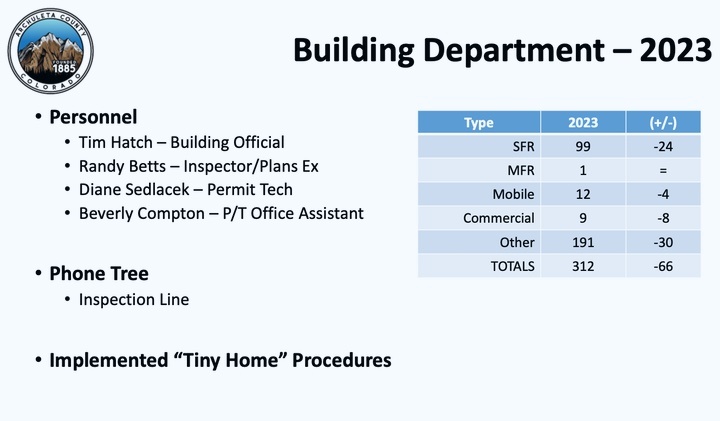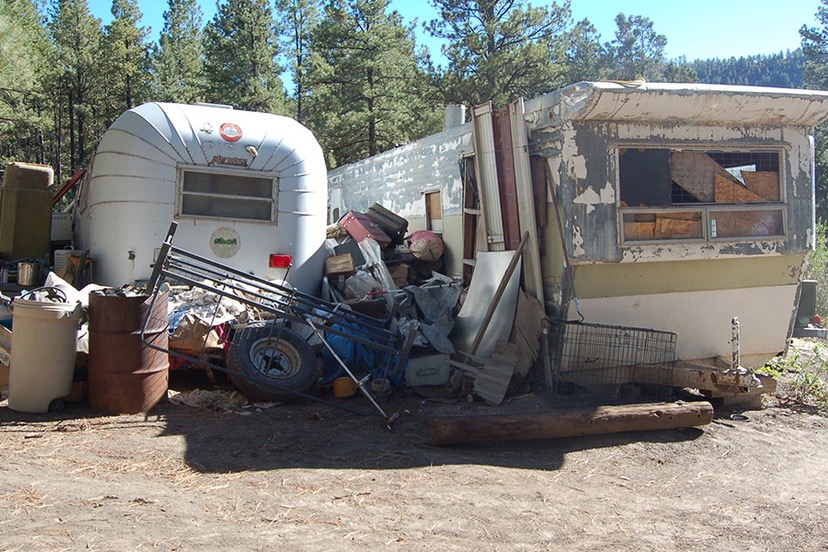In response to Archuleta County Development Director Pam Flower’s comment — suggesting that the County could steer away from punishment, per se, for land use violations, and begin to shift the focus of code enforcement towards ‘Community Engagement and Assistance’ — we heard from County Commissioner Ronnie Maez,
He thought the BOCC ought to be providing input on how the change, from a punitive government to a supportive government, might take place; referring specifically to the County’s Nuisance Ordinance…
…sometimes called the Junk Ordinance.
“I think it’s way too strict, the way it is right now. And we all know that. But the thing is, I find it kind of hard to understand that La Plata County doesn’t even have a junk ordinance, and they are doing fine over there.”
Director Flowers:
“Well, that’s the rewrite we’re talking about…”
Commissioner Maez:
“Yeah, I don’t know about rewriting it — or not having one at all. Or maybe having a compromise on the amounts. Maybe junk vehicles is the biggest issue.”
Director Flowers:
“I have some pretty good ideas on how we can get past that. But I know [County Manager Derek Wopodman] is working on that. My point in putting this idea forward, is driven partly by Errol’s idea to be more supportive; it’s also driven by the feedback I’ve gotten from [the BOCC]. I want to bring the Enforcement office into more of a support effort, and less of an ‘enforcement’ effort… that’s the direction we’d like to try and go with code enforcement…”
The Archuleta County Nuisance Ordinance was first created about 15 years ago, as the result of a clash of cultures in the more rural parts of the county, where a relaxed lifestyle had traditionally included the ability to store building materials, agricultural equipment, recreational vehicles, and older, non-operational cars and trucks on a person’s property, out in the open air.
As the community’s population grew at a surprising rate during the 1990s and early 2000s with an influx of Baby Boomer retirees from big cities, what had once been a rural lifestyle became a subdivision nuisance that “lowered property values”.
This was not an issue in the Pagosa Lakes subdivisions, because from that development’s very beginnings, the property owner covenants, conditions and restrictions (CC&Rs) prohibited outdoor storage.
In an apparent attempt to create similar conditions and restrictions on the rural subdivisions outside Pagosa Lakes, the then-commissioners wrote a new Nuisance Ordinance, to be “complaint based”. They basically defined outdoor storage as illegal, but directed the County staff to enforce the ordinance only when a neighbor filed a complaint about the ‘junk’ next door.
Naturally, this construction of the law merely added to the conflicts between traditional rural residents and the newcomers. And it placed the County staff and BOCC in the middle of those conflicts.
Commissioner Maez grew up in Archuleta County, before it became a retirement and tourist wonderland, and presumably understands the quarrels from that perspective.
Commissioner Maez:
“Yeah, and I think the community engagement, on the original [Nuisance Ordinance]… I don’t think it saw a lot of public review back then. I’ve always believed that less is more.”
As I mentioned in Part Two, this discussion reflects a general sense I have, that our local governments are slowly becoming concerned about policies and enforcement practices that, unintentionally, drive working-class families out of the community.
Commissioner Veronica Medina then changed the subject, and asked for clarification about the grants recently awarded to the community to address workforce housing. Ms. Flowers explained that the recent grants have been a joint effort by the Town, the County, and Pagosa Springs Community Development Corporation (PSCDC).
Does the Development Services department need more help with grant writing? Now that the state of Colorado and the federal government are more generously supporting housing efforts with grant opportunities?
Ms. Flowers:
“I’m learning. I’m learning how to write the grants, better, and I’ve got the support from the PSCDC, and from the Town. So I’m learning. I’m not yet a grant expert. The state is always very helpful, in helping me figure out how to get the application done.
“So right now, I’m not at all overwhelmed by it. The reorganization we did, when you allowed me to hire a planning manager to take [certain tasks] off my plate, part of the goal was to free me up to do stuff at a higher level, like grants that will benefit everybody. So, right now, I don’t feel that I need help with [grant writing]…
“I can actually answer phone calls the same day, now that I have a planning manager.”
She then summarized the “solid team” currently running the Building Department.

As we might notice, the number of new homes and commercial projects had declined from 2022. Down by about 20%.
Ms. Flowers noted that the state has revised its laws to allow ‘tiny homes’ to receive a label — an ‘insignia’ — declaring that they were built to certain residential standards and can be safely occupied as a permanent dwelling. Previously, ‘tiny homes’ in Colorado and in most communities were treated as ‘recreational vehicles’ and were not allowed to be used a permanent dwellings.
You can view the revised law here.
The main issue, according to Director Flowers, concerns electric and plumbing, which — if certified — would allow these small homes to be connected to public utilities. And possibly, to be insured?
Ms. Flowers then expressed some concerns about the pressure, coming from the state of Colorado, urging local governments to adopt the 2021 Energy Code.
That’s a can of worms.
And not the kind that are easy to swallow.

